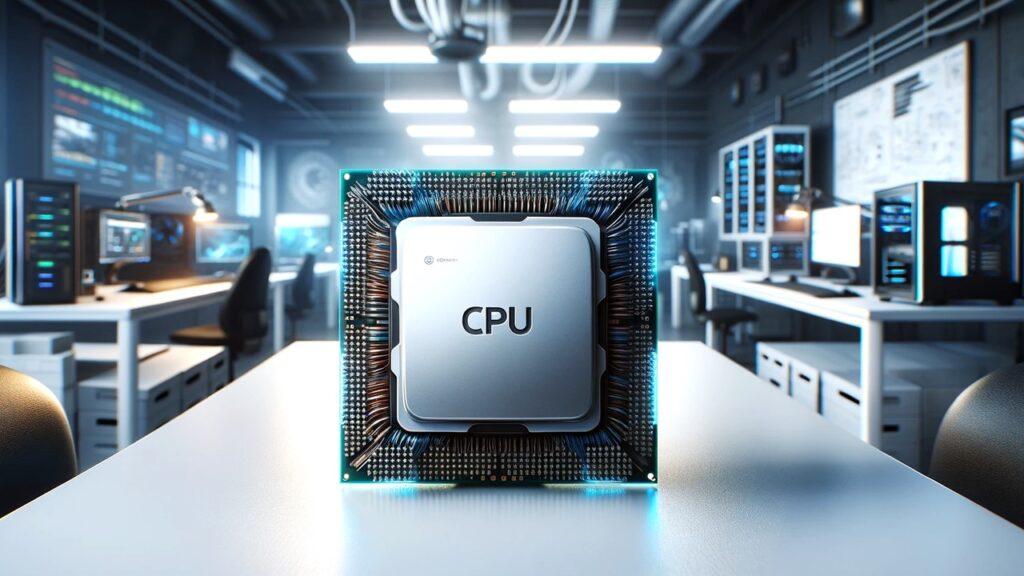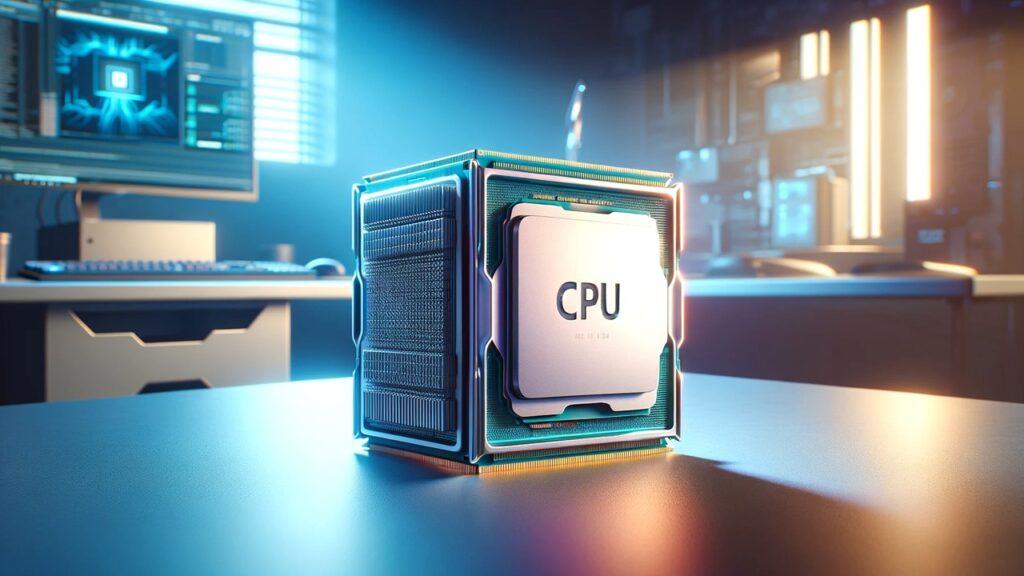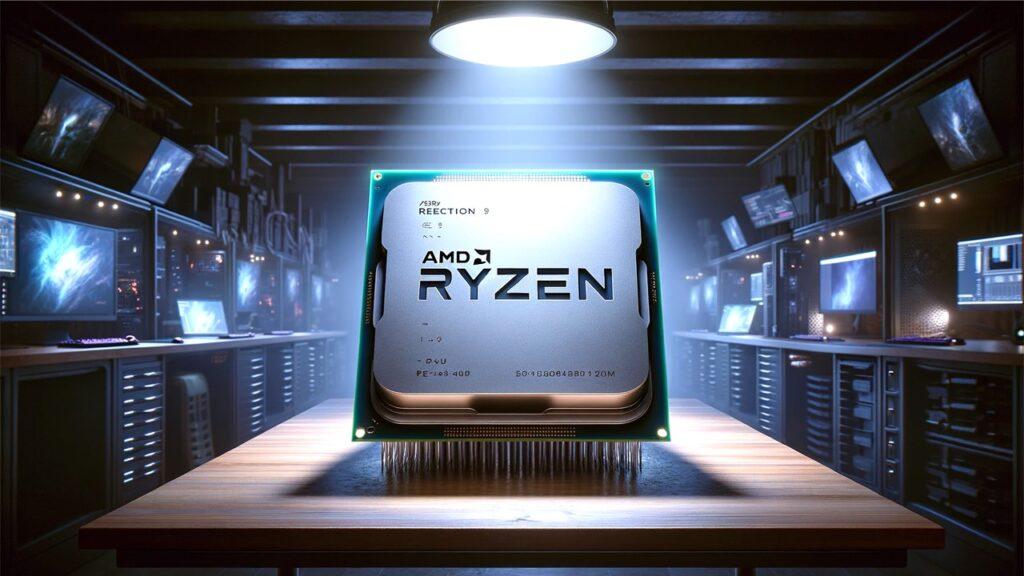Understanding the role of a portable SSD in PC builds is more crucial than ever. These devices not only provide significant speed advantages but also enhance the reliability of your external storage solutions. Additionally, choosing the right SSD can dramatically improve your system’s performance and responsiveness, especially important in data-intensive environments. In this guide, we have extensively researched, reviewed, and ranked the 5 best portable SSDs for external storage PC builds in 2024. This ensures you can choose the right portable SSD for external storage PC build from the many choices.
We’re reader-supported. When you buy through links on our site, we may earn an affiliate commission. As an Amazon Associate, we earn from qualifying purchases.
Our Top Picks Of The Best Portable SSDs for External Storage PC Build Needs In 2024
1. Best Overall: SanDisk Professional PRO-G40 SSD
2. Best Value: Crucial X9
3. Best Security: SAMSUNG SSD T7
4. Best Speed: SanDisk Extreme PRO
5. Best Rugged: SAMSUNG T7 Shield
What Is The Best Portable SSD for External Storage PC Builds In 2024?
Choosing the best portable SSD for your external storage needs in PC builds can be pivotal. These drives offer unprecedented speed and reliability, crucial for modern computing tasks. Furthermore, the right SSD can drastically enhance your system’s overall efficiency and responsiveness. Moreover, with the variety of options available, selecting an SSD that aligns perfectly with your PC setup ensures optimal performance and durability.
1. Best Overall: SanDisk Professional PRO-G40 SSD
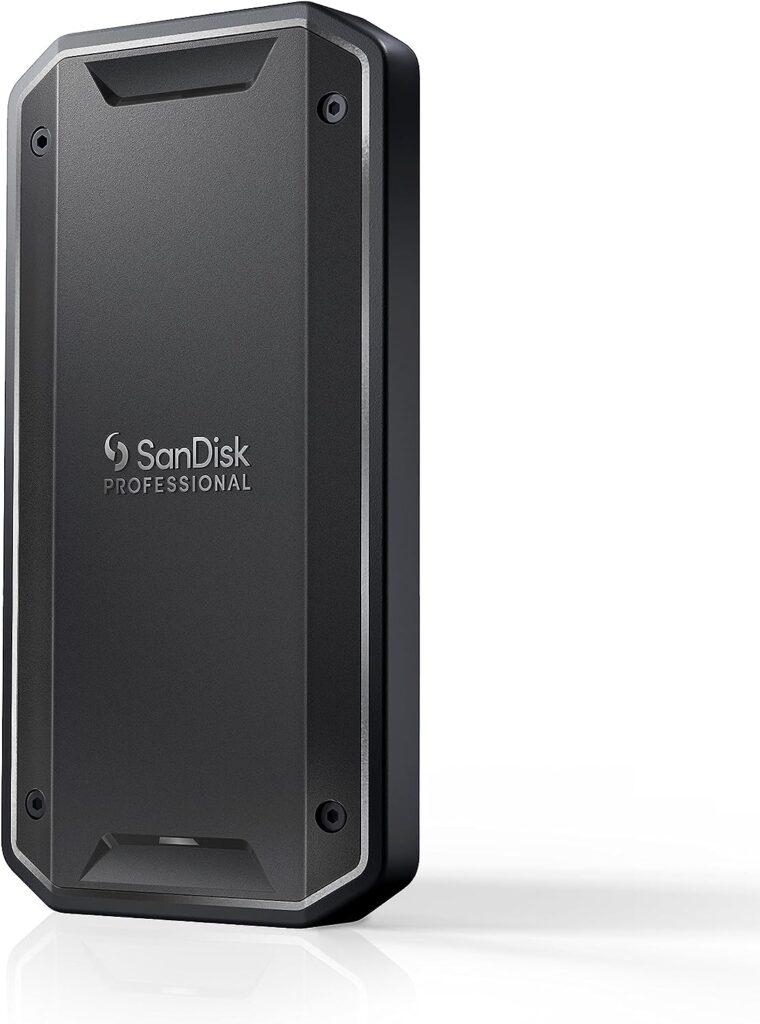
Quick Specifications
- Storage: 4 TB
- Interface: USB 3.0
- Connectivity: USB 3.0 , Thunderbolt
- Form Factor: 2.5 Inches
- Read/Write Speed: 3000MB/s read, 2500MB/s write
- Features: Portable, Dust/Water Resistant
In our assessment, the SanDisk Professional PRO-G40 SSD is a standout performer, especially when it comes to heavy-duty external storage for PC builds. This SSD offers large storage and it also has blazing-fast read and write speeds of up to 3000MB/s and 2500MB/s, respectively. Additionally, its compatibility with both Thunderbolt 3 and USB-C makes it incredibly versatile for various technological environments.
Moreover, its rugged construction ensures that it isn’t just another delicate piece of technology. With IP68 ratings for dust and water resistance and the ability to withstand a 4000lb crush, this SSD is built to last under tough conditions. It’s perfect for professionals who need a dependable drive that can travel as hard as they do.
Pros
- Exceptional speed capabilities streamline complex tasks.
- Compatible with multiple interfaces, enhancing its utility.
- Highly durable build suited for outdoor or rugged use.
- Efficient heat dissipation keeps the device cool during intense operations.
Cons
- May require additional software for optimal performance with some PC setups.
- The size might be slightly cumbersome for ultra-mobile users.
In our view, the SanDisk Professional PRO-G40 SSD is an excellent choice within our list for those looking to enhance their external storage solutions for PC builds. Its robust build and fast data transfer capabilities allow it to perform superbly across various demanding conditions and tasks. If you’re looking for a reliable, high-capacity, and versatile external SSD, this model merits serious consideration in our opinion.
2. Best Value: Crucial X9
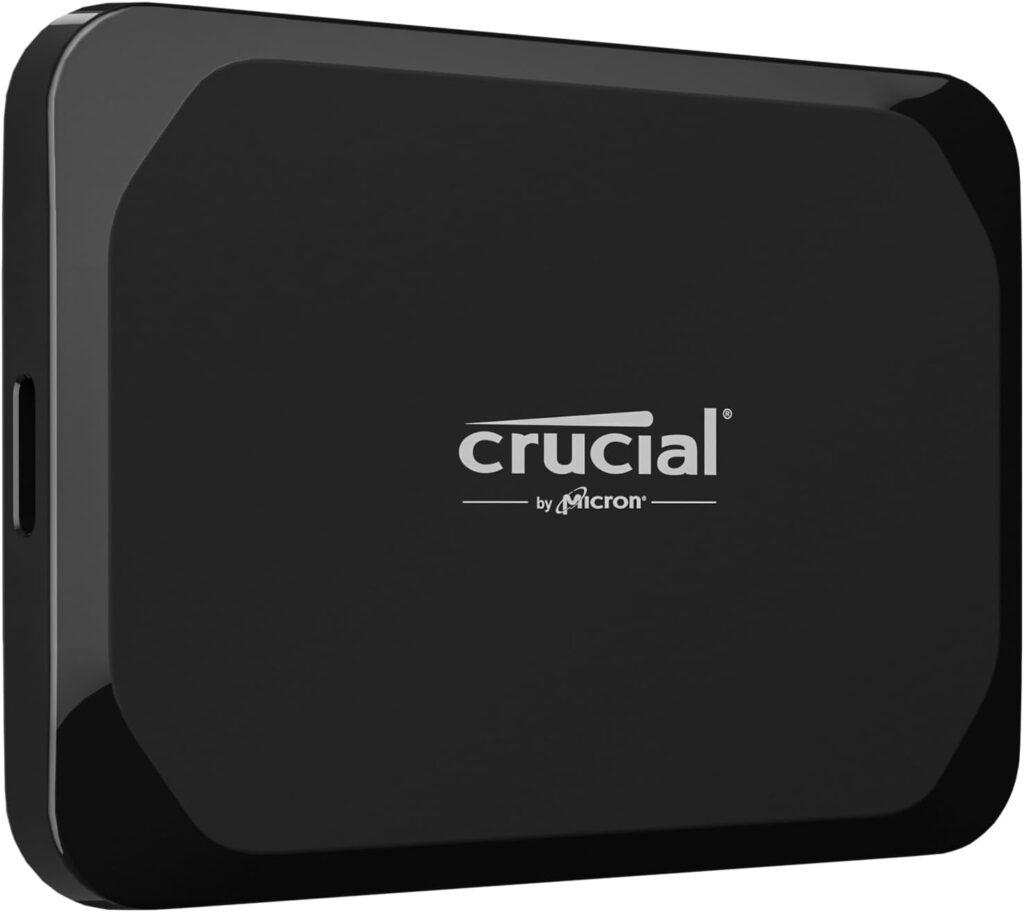
Quick Specifications
- Storage: 2 TB
- Interface: Solid State
- Connectivity: USB
- Form Factor: 2.5 Inches
- Read/Write Speed: 1050MB/s Read
- Features: Portable, Shock Resistant, Durable
In our view, the Crucial X9 Portable SSD offers an impressive blend of performance and durability, making it an outstanding choice for those looking to expand their external storage options for PC builds. Its compact size and shock-resistant design allow for easy transportation and use in various environments without worrying about data loss.
Furthermore, the Crucial X9 is not only spacious, providing ample room for photos, videos, and games, but also boasts remarkable compatibility across devices. This versatility makes it ideal for users who switch between multiple platforms such as Windows, Mac, gaming consoles, and Android devices.
Pros
- Offers fast read speeds up to 1050MB/s, enhancing file transfer efficiency.
- Extremely lightweight and portable, making it easy to carry.
- Shock and vibration proof, designed for robust use.
- Broad compatibility with various devices enhances user convenience.
Cons
- The write speed might not match the top-tier SSDs available today.
- Larger file transfers could slow down due to the read-focused speed.
In our opinion, the Crucial X9 emerges as an excellent choice due to its solid performance, reliability, and compatibility on our list. It’s a practical solution for those who need dependable and quick external storage for their diverse tech ecosystem from our perspective.
3. Best Security: SAMSUNG SSD T7
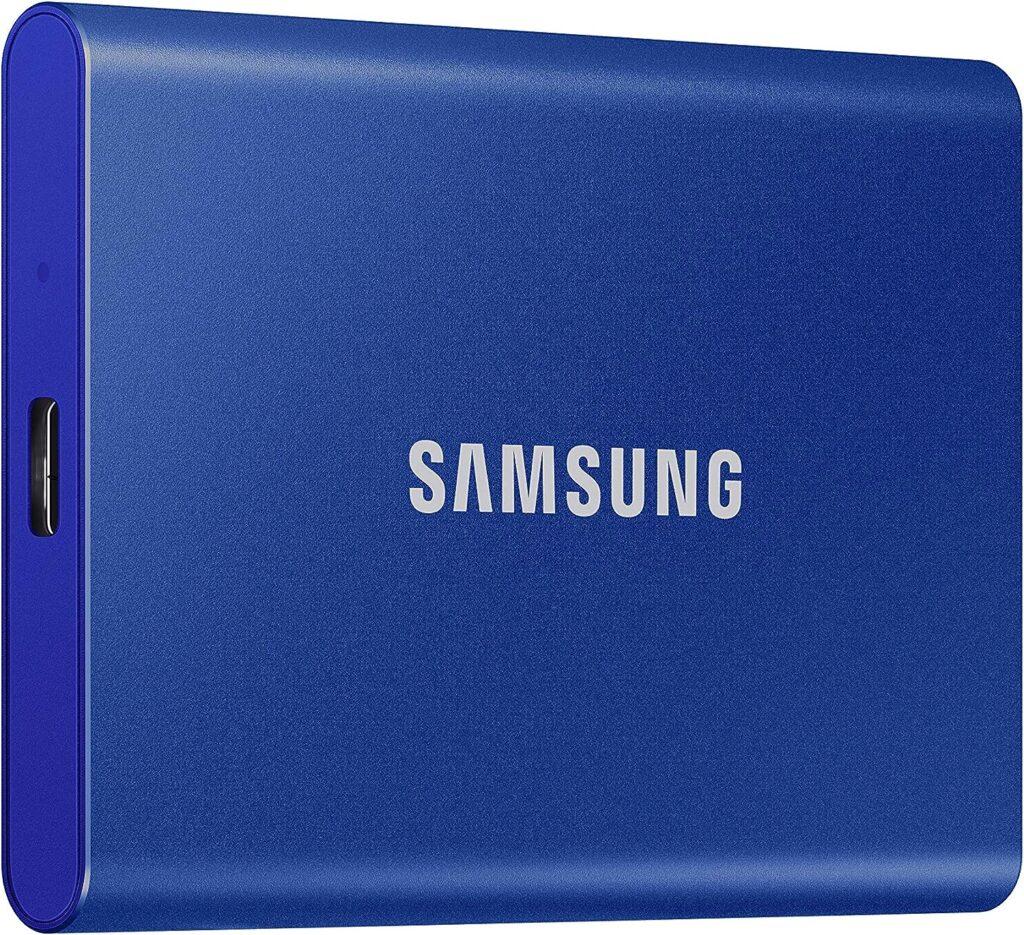
Quick Specifications
- Storage: 2 TB
- Interface: USB 3.2
- Connectivity: USB
- Form Factor: 2.5 Inches
- Read/Write Speed: 1050MB/s Read, 1000MB/s Write
- Features: Portable, Shock Resistant
From our standpoint, the SAMSUNG SSD T7 provides top-notch security and performance for PC builders and tech enthusiasts alike. Its robust design and fast data transfer rates make it an ideal choice for professionals and students who need reliable storage on the go. Furthermore, the SSD’s shock resistance ensures your data is protected even in challenging environments.
Moreover, the SAMSUNG SSD T7 shines with its seamless compatibility across a variety of devices. Whether you’re transferring crucial business documents or backing up vast media collections, this SSD handles it all efficiently. Its sleek, compact style also means it fits into nearly any setup without clutter.
Pros
- Extremely fast transfer speeds facilitate quick file access and backups.
- Durable design offers added protection against physical damage.
- Lightweight and compact, perfect for on-the-go use.
- Broad device compatibility enhances user convenience.
Cons
- High performance might come with a higher power consumption.
- Some users may prefer more color options to match their gear.
In our opinion, the SAMSUNG SSD T7 is the right choice for those prioritizing security and speed in their external storage solutions on our list. With its robust build and advanced thermal solutions, it stands out as an excellent choice for safeguarding and accessing your data swiftly and reliably from our perspective.
4. Best Speed: SanDisk Extreme PRO
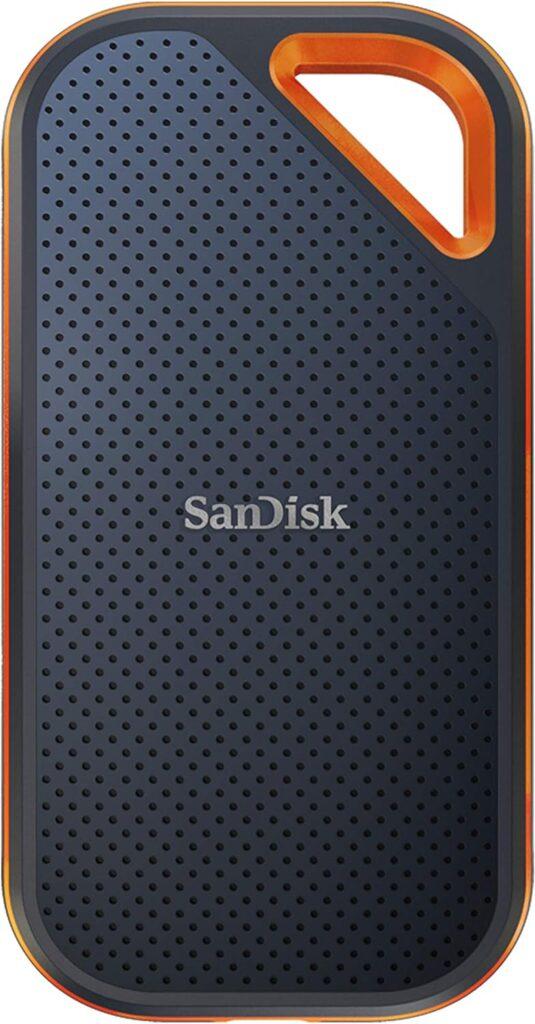
Quick Specifications
- Storage: 2 TB
- Interface: eSATA
- Connectivity: USB
- Form Factor: 2.5 Inches
- Read/Write Speed: 2000MB/s
- Features: Dust Resistant, Water Resistant, Portable, Hardware Encryption
From our standpoint, the SanDisk Extreme PRO Portable SSD stands as a top contender for those who prioritize speed in their external storage solutions. Its ability to deliver up to 2000MB/s read and write speeds makes it a powerhouse for transferring large files quickly and efficiently. Moreover, the robust aluminum chassis ensures that this speed does not come at the cost of durability.
Furthermore, the SanDisk Extreme PRO provides reliable performance under tough conditions, which is crucial for professionals who are often on the move. Whether it’s on a shoot or in the field, this SSD’s resistance to water and dust along with drop protection makes it a steadfast companion.
Pros
- Exceptional read and write speeds enhance workflow productivity.
- Rugged build provides durability in harsh environments.
- Compact and lightweight design makes it extremely portable.
- Includes hardware encryption to secure sensitive data.
Cons
- The eSATA interface may require adapters for some users.
- High-performance comes with a higher energy demand.
In our opinion, the SanDisk Extreme PRO emerges as an excellent choice for those who need swift and secure storage solutions on our list. It perfectly blends speed with security, ensuring that your data not only transfers quickly but also remains protected under all circumstances. This makes it an ideal selection for content creators and IT professionals alike who demand top-tier performance and reliability from their external storage devices from our perspective.
5. Best Rugged: SAMSUNG T7 Shield
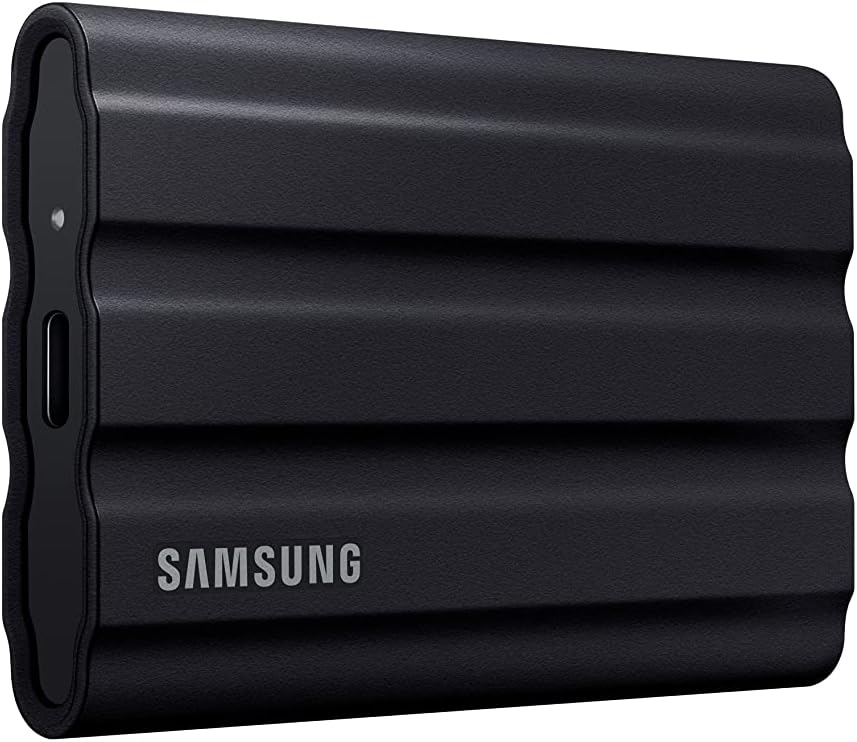
Quick Specifications
- Storage: 2 TB
- Interface: USB 3.0
- Connectivity: USB
- Form Factor: 2.5 Inches
- Read/Write Speed: 1050/1000 MB/s
- Features: Portable, Water and Dust Resistance
In our experience, the SAMSUNG T7 Shield stands out as the most rugged portable SSD for external storage in PC builds. Its durability is unmatched, designed to brave the elements and withstand tough environments. Moreover, the drive’s high resistance to water and dust, coupled with its drop protection, makes it an excellent choice for adventurers or professionals working in challenging conditions.
Furthermore, the SAMSUNG T7 Shield offers impressive speed, making it nearly twice as fast as its predecessor. This speed, combined with its robustness, ensures that your data not only remains secure but is also quickly accessible, no matter where your work takes you.
Pros
- Exceptional resistance to water, dust, and drops enhances durability.
- Fast read and write speeds improve efficiency.
- Lightweight and compact, easy to carry.
- Compatible with multiple devices and platforms.
Cons
- The rugged features may add to the cost.
- Some may find the color options limited.
In our opinion, the SAMSUNG T7 Shield is the right choice for those who need reliable protection for their data in extreme conditions on our list. Its combination of speed, durability, and portability makes it an excellent choice for anyone who values data security and fast access while on the move from our perspective.
Portable SSDs: Enhancing PC Builds with Speed and Mobility
Portable SSDs have revolutionized how we think about data storage in PC builds. These devices blend speed, durability, and portability to meet modern computing demands. Here, we explore the essence of portable SSDs for external storage and their transformative impact on PC builds.
What Exactly is a Portable SSD?
A portable SSD is a small, sturdy storage device using solid-state technology. It stores data persistently, without the moving parts found in traditional hard drives. This makes it more resilient and reliable. Portable SSDs typically connect via USB or Thunderbolt, making them versatile for various devices.
The Critical Role of SSDs in External Storage for PC Builds
Portable SSDs significantly enhance PC performance, especially valuable for users who prioritize efficiency. Integrating a portable SSDs for external storage speeds up boot times and application performance. Moreover, these drives are ideal for transporting large data volumes safely, beneficial for professionals across various fields.
SSDs offer faster data access than traditional hard drives. This speed is crucial for tasks requiring quick read/write operations, like video editing or gaming. Portable SSDs also support data backup, ensuring quick recovery during system failures. Their robust build minimizes risk, safeguarding data against physical damage.
Portable SSDs are pivotal for modern PC setups. They not only accelerate performance but also enhance data security and system reliability. Their adaptability across different computing environments highlights their importance in today’s digital landscape.
How To Choose The Right Portable SSD for External Storage PC Build
Choosing the right portable SSD for your PC build is about finding the optimal blend of performance, compatibility, and specific needs. This guide will help you navigate the crucial criteria to ensure you pick the best SSD for your system’s requirements.
Decoding SSD Specifications
To make an informed choice, it’s vital to understand the specifications of a portable SSDs for external storage and how they affect its performance. Consider these key factors:
- Storage Capacity: Essential for those who manage large files or extensive media collections.
- Read/Write Speeds: Critical for enhancing system responsiveness by allowing faster access to data.
- Durability: Important if the SSD will be used in various environments, potentially exposed to physical shocks or extreme temperatures.
- Form Factor: Depends on the physical space available and your portability needs; smaller SSDs are preferable for frequent travelers.
Understanding these specifications can help you match the SSD to your performance expectations and storage requirements.
Ensuring Compatibility with PC Components
Compatibility is crucial when integrating a new SSD into your existing setup. Here’s what to check:
- USB Port Type: Ensure that your PC’s USB port type matches the SSD’s requirements to take full advantage of its speed capabilities. For instance, a USB 3.2 Gen 2×2 port is necessary for the fastest data transfer rates.
- System Requirements: Check whether the SSD is formatted for and compatible with other devices you might use, such as gaming consoles or Macs. Some SSDs may require additional drivers or software.
Selecting the right portable SSDs for external storage enhances your PC’s efficiency and effectiveness. By focusing on both specifications and compatibility, you can ensure that your new SSD meets your performance needs and works seamlessly with your existing PC components.
Evaluating Interface Options for Portable SSDs
When choosing a portable SSDs for external storage, interface options are crucial to consider. Each type of connection can dramatically impact the speed and efficiency of data transfers. In this section, we delve into the differences between USB 3.2 Gen 2×2 and Thunderbolt 3, as well as explore how USB4 is reshaping the landscape of external storage solutions.
USB 3.2 Gen 2×2 vs. Thunderbolt 3
USB 3.2 Gen 2×2 represents a significant advancement in USB technology, offering speeds up to 20Gbps. This makes it twice as fast as its predecessor, enhancing file transfer rates considerably. It’s a robust choice for users needing high-speed data access without the premium cost of Thunderbolt 3. Furthermore, its compatibility with existing USB ports ensures it fits into most tech ecosystems effortlessly.
On the other hand, Thunderbolt 3 is the powerhouse among interfaces. It supports speeds up to 40Gbps—double what USB 3.2 Gen 2×2 offers. Thunderbolt 3 also provides power delivery and the ability to connect to multiple devices through daisy-chaining. These features make it an ideal choice for professionals who require top-tier performance and versatility from their devices.
The Advancement of USB4 and Its Impact
The introduction of USB4 marks a pivotal development in portable storage technology. USB4 combines the best features of USB 3.2 Gen 2×2 and Thunderbolt 3, offering speeds up to 40Gbps. Additionally, it supports multiple data and display protocols, which increases its utility. The backward compatibility with older USB versions ensures that users won’t need to replace their existing devices to benefit from USB4.
Moreover, the universal acceptance of USB4 can significantly simplify how we connect devices, streamlining operations and reducing cable clutter. Its impact extends beyond speed, fostering a more unified and efficient experience across various devices and platforms.
When selecting a portable SSDs for external storage, considering the interface type is more important than ever. Whether you choose the affordability and compatibility of USB 3.2 Gen 2×2, the high performance of Thunderbolt 3, or the future-proof technology of USB4, each option offers distinct benefits tailored to different needs. As technology advances, these interfaces will continue to evolve, further enhancing how we store and access our data on the go.
Installation and Setup of Portable SSDs in PC Builds
Elevating your PC build with a portable SSDs for external storage not only boosts your system’s storage capabilities but also enhances its overall performance. This guide focuses on the straightforward installation process and the essential optimization steps that ensure your PC operates at its highest efficiency.
Step-by-Step Guide to Installing an External SSD
Upgrading your PC with an external SSD is a simple yet impactful enhancement. Start by powering down your PC and disconnecting it from any power sources. Identify an available USB or Thunderbolt port that matches your SSD’s interface for optimal performance. Connect the SSD to your PC using the provided cable. Due to plug-and-play technology, most systems will automatically recognize the new device.
If prompted to format the SSD, choose the appropriate file system—NTFS for Windows or exFAT for cross-platform compatibility. This step readies your SSD for immediate use, storing files and running applications.
Configuring SSDs for Optimal Performance
With the SSD installed, fine-tuning your system to maximize the SSD’s performance is crucial. Reboot your PC and enter the BIOS or UEFI setup by pressing the specific key shown during the initial boot phase, typically ‘Delete’ or ‘F2’. Navigate to the section dedicated to storage or peripheral devices to adjust your SSD’s settings.
Ensure the SSD’s port is set to operate without any power restrictions to maximize throughput. If available, enable settings like UASP (USB Attached SCSI Protocol) to enhance data transfer efficiency significantly.
These adjustments help your SSD reach its full potential, leading to faster system boot-ups, swift file accesses, and overall enhanced responsiveness. By meticulously setting up and optimizing your portable SSD, you lay the groundwork for a powerful, efficient computing setup that meets the demands of advanced software applications and large data transfers.
The correct installation and meticulous configuration of your portable SSDs for external storage are critical for achieving a superior performance level in your PC build. Following these detailed steps ensures that your system not only meets but surpasses performance expectations, providing a robust and responsive computing experience.
Security and Data Protection for External SSDs
Protecting the data on your external SSD is paramount in an era where digital security threats are increasingly common. This guide focuses on robust encryption methods and best practices for data safety, ensuring comprehensive security for your portable storage.
Encrypting Your SSD
Encryption is your first line of defense, transforming data into a format that can only be read with the correct decryption key or password. Here’s how to effectively encrypt your external SSD:
- Select Reliable Encryption Software: Choose either the encryption tools provided with your SSD or reputable third-party software. For Windows users, BitLocker offers robust encryption, while macOS users can rely on FileVault.
- Create a Strong Password: Your encryption password is crucial. Opt for complexity with a mix of letters, numbers, and symbols, and keep it confidential.
- Backup Data Beforehand: Always back up your data before starting the encryption process to avoid potential data loss.
- Initiate Encryption: Follow the encryption software’s instructions to encrypt your SSD. This typically involves formatting the drive, so ensure your backup is secure.
- Safeguard Recovery Keys: Post-encryption, store any recovery keys in a secure location apart from your SSD. These are vital in case you forget your password.
Encrypting your SSD secures your data against unauthorized access, making it an essential practice for anyone looking to protect sensitive information effectively.
Right Practices for SSD Data Safety
Beyond encryption, safeguarding your data encompasses adopting the following best practices to mitigate risks of data loss or compromise:
- Stay Updated: Regularly update your SSD’s firmware and any related software to protect against known vulnerabilities and enhance functionality.
- Protect Physically: Store your SSD in a secure location when not in use to prevent physical theft or damage.
- Utilize Antivirus Protection: Equip your computer with robust antivirus software to thwart malware infections that could compromise your SSD.
- Control Connection Environments: Exercise caution when connecting your SSD to public computers or networks, which are often less secure.
- Employ DLP Strategies: In corporate settings, use Data Loss Prevention tools to monitor and regulate data stored on SSDs, preventing unauthorized access or duplication.
- Follow Proper Ejection Procedures: Always eject your SSD properly to prevent data corruption. This ensures file integrity and system stability.
Implementing these practices enhances the security of your data on an external SSD, providing a layered defense against various threats. Regular review and adaptation of these security measures are crucial in maintaining the effectiveness of your data protection strategy.
Securing your external SSD involves more than just the initial setup; it requires ongoing vigilance in both digital and physical realms. By following these detailed encryption guidelines and safety practices, you ensure that your data is not only secure but also maintained under optimal conditions, allowing for reliable and safe usage of your external storage solutions.
Durability and Reliability of Portable SSDs
Choosing a portable SSD goes beyond just capacity and speed. Durability and reliability are critical for those who rely heavily on their storage devices. This segment highlights the built-in durability features of SSDs and the extensive testing they undergo to ensure reliability under varied conditions.
What Makes SSDs Durable?
The main advantage of portable SSDs is their solid-state architecture. Unlike traditional HDDs, SSDs have no moving parts, significantly reducing the risk of mechanical failures. This makes them particularly resilient against physical shocks and vibrations. Ideal for those who are always on the move.
Additionally, features like wear leveling and error correction code (ECC) enhance longevity and data integrity. Wear leveling prevents any section of the SSD from getting overused. ECC, meanwhile, ensures that any data errors are automatically detected and corrected.
Testing SSD Endurance
Testing the endurance of portable SSDs for external storage is crucial for determining its longevity. Manufacturers use rigorous tests to simulate real-world usage. One key measure they look at is the Total Bytes Written (TBW). TBW indicates how much data can be written to the SSD before wear affects its functionality.
These tests also expose SSDs to extreme conditions, such as varying temperatures and abrupt power losses. Such thorough testing ensures that the SSD can handle not just everyday tasks but also intensive applications like 4K video editing.
The durability and reliability of portable SSDs are essential for those who need dependable and robust storage. Thanks to their solid-state design and rigorous testing, SSDs are well-equipped to handle a range of challenging environments and heavy usage, making them a wise investment for data safety and performance.
Cost vs. Benefit Analysis of Portable SSDs for PC Builds
When crafting the ideal PC setup, selecting the appropriate storage solution is essential. Portable SSDs excel in providing rapid access and reliable performance, although they come with a higher price tag. This analysis delves into the cost-effectiveness of incorporating high-performance SSDs into your build and examines how they stack up against other storage alternatives.
Analyzing the Investment in High-Performance SSDs
Investing in a high-performance SSD boosts your PC’s speed and efficiency. These drives reduce boot times and improve data access significantly. They also lower the risk of data loss since they lack moving parts. Despite their higher initial cost, the performance boost and durability often justify the expense, especially as SSD prices continue to drop.
For professionals working with 4K video or gamers needing fast loading times, SSDs are particularly beneficial. The cost is offset by the dramatic enhancements in performance and reliability.
Comparison with Alternative Storage Solutions
Comparing portable SSDs with HDDs and hybrid drives sheds light on their value. HDDs cost less and offer more storage per dollar but lag in performance and are more prone to damage. Hybrid drives mix HDD capacity with SSD caching but don’t match SSDs’ consistent performance.
Portable SSDs might seem expensive initially compared to HDDs or SSHDs, but their superior speed, efficiency, and durability provide substantial long-term benefits. As SSD technology advances, increasing capacity and becoming more cost-effective, their value only grows. For those who prioritize performance and reliability, investing in an SSD is a smart choice.
Wrapping It Up!
The performance and dependability of your computer can be significantly improved by selecting the ideal portable SSD for external storage. These drives are a big deal for their quick access to data and solid durability, making them a must-have in today’s digital world. Adding a high-performance SSD to your setup? Expect a serious speed boost, from lightning-fast boot times to smoother file transfers.
Portable SSDs really outperform traditional HDDs and hybrid drives across the board. They offer faster performance, better reliability, and since they don’t have any moving parts, they’re a lot less likely to suffer damage. That’s a big plus for anyone who needs their data safe and sound while on the go.
What’s more, the cost of a high-performance SSD might seem steep, but it pays off, especially if you’re into heavy-duty tasks like 4K video editing or competitive gaming. SSDs are also more power-efficient, which is great news for your laptop’s battery life.
All in all, picking the right portable SSD is crucial if you’re looking to step up your system’s overall performance and security. Whether you’re a pro needing top-tier performance or just after reliable and fast storage, SSDs offer a killer combo of speed, durability, and efficiency. Investing in a good SSD? That’s a smart move that will boost both your performance and your peace of mind.
Related FAQs
What Makes Portable SSDs Better Than Traditional HDDs?
Portable SSDs are quicker, tougher, and more reliable because they don’t have any moving parts, unlike traditional HDDs.
How Do SSDs Stack Up Against HDDs in Terms of Storage?
HDDs might give you more bang for your buck when it comes to storage space, but SSDs catch up with options that go up to several terabytes.
Can I Use My Portable SSD on Both Windows and Mac?
Absolutely! You can use portable SSDs with both Windows and Mac systems, though you might need to reformat them depending on how they’re initially set up.
What Should I Look Out For When Picking a Portable SSD?
Check out the SSD’s capacity, speed, price, and how tough it is. Also, make sure it plays nicely with your system.
Is My Data Safe on a Portable SSD?
Yes, many portable SSDs have encryption features built-in, making them a secure spot for your sensitive info.

At our core, we’re a group of passionate tech lovers, just like you. We dive deep into the world of tech, especially when it’s about building PCs that perform. We try to provide as much value to the readers with our information and how to blog articles as possible. For affiliate articles our honest and transparent reviews of essential tech products are rooted in real-world experience. We take great satisfaction in offering unbiased evaluations, ensuring that you can make informed decisions when investing in your desired techs. As an affiliate website, we may earn a small commission from some of the products we feature. However, rest assured that our opinions are not influenced by this, and your trust is always our main priority.


